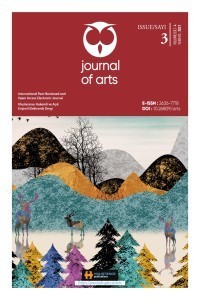Covi̇d-19 pandemi̇ süreci̇nde müzelerde çevri̇mi̇çi̇ (onli̇ne) eği̇ti̇m etki̇nli̇kleri̇ne yöneli̇k bi̇r değerlendi̇rme: İstanbul ve New York
Dünyayı etkisi altına alan Covid-19 pandemisi nedeniyle, hayatın her alanında olduğu gibi eğitim ve sanat alanında da tüm çalışmaların sekteye uğradığı bugünlerde, okul dışı öğrenme ortamlarından ve yaygın eğitim kurumlarından olan müzelerin de bazı düzenlemelere gittikleri görülmektedir. Bu düzenlemelerle müzeler etkinliklere ara vermek ya da azaltmak, sınırlı sayıda ziyaretçi kabul etmek ya da kapılarını ziyaretçilerine kapatmak zorunda kalmıştır. Ancak hem pandemi şartlarına hem de çağın gerektirdiği dijital dünyaya uyum sağlamaya çalışan müzeler ziyaretçilerine yönelik eğitim etkinliklerini hızlı bir şekilde çevrimiçi olarak uzaktan gerçekleştirmeye başlamışlardır. Bu araştırma, müzelerin pandemi sürecinde çocuklara yönelik çevrimiçi eğitim etkinliklerine odaklanmaktadır. Araştırmada New York ve İstanbul’da çocuklara yönelik çevrimiçi eğitim etkinlikleri bulunan sanat müzelerinin bir karşılaştırması yapılarak güncel durum ortaya konulmaya çalışılmıştır. Araştırma nitel araştırma yaklaşımlarından durum çalışması deseniyle gerçekleştirilmiştir. Araştırmanın kapsamını, sanat merkezi olduğu düşünülen New York ve İstanbul’da yer alan altı sanat müzesi oluşturmaktadır. Araştırma verileri doküman incelemesi yöntemiyle toplanmıştır. Araştırmada müzelerin kurumsal internet sayfalarından erişilen bilgiler betimsel olarak analiz edilmiştir. New York müzelerinin çocuklara yönelik eğitim etkinliklerinde çok geniş bir erişim olanağı sunduğu İstanbul müzelerinde de oldukça kaliteli eğitim etkinliklerinin bulunduğu ancak hem çocuk ve ailelere yönelik eğitim etkinliklerinin hem de çevrimiçi erişilebilecek dosyalar ile video ve ses kayıtlarının sayısının artırılması gerektiği sonucuna ulaşılmıştır. Ayrıca çevrimiçi eğitimin, müzelerin fiziksel olarak ziyaret edilmesiyle gerçekleştirilen eğitimin yerini tutmasa da Covid-19 pandemi süreci sonrasında da müzelerde yüz yüze eğitime destek bir eğitim modeli oluşturacağı düşünülmektedir
Anahtar Kelimeler:
müzede eğitim, çevrimiçi eğitim etkinlikleri, pandemi, covid-19
An evaluation for online educational activities in museums during the covid-19 pandemic period: Istanbul and New York
In these days, where all work is interrupted in the field of education and art, as in all areas of life due to the Covid-19 pandemic, which has affected the world, it is seen that museums, which are non-school learning environments and non-formal education institutions, have also made some regulations. With these regulations, museums had to pause or reduce activities, accept a limited number of visitors or close their doors to visitors. However, museums trying to adapt to both the pandemic conditions and the digital world required by the age have quickly started to conduct online educational activities for their visitors, remotely. This study focuses on museums’ online educational activities for children during the pandemic period. In the research, the current situation was tried to be revealed by making a comparison of the art museums with online educational activities for children in New York and Istanbul. The research was conducted through the case study design, one of the qualitative research methods. Six art museums located in New York and Istanbul, which are considered to be art centers, constitute the scope of the research. Research data were collected by document analysis method. In the research, the information accessed from the institutional web pages of the museums was analyzed descriptively. It has been concluded that the museums of New York offer a wide range of educational activities for children and the museums of Istanbul have very high quality educational activities, but the number of educational activities for children and families, as well as online files and video and audio recordings, should be increased. In addition, although online education activities do not replace the education carried out by visiting museums physically, it is believed to create an education model that supports face-to-face education in museums after the pandemic.
Keywords:
education in museum, online education activities, pandemic, covid-19,
___
- ATAGÖK, T. (1999). Çağdaş Müzeciliğin Anlamı; Müze ve İlişkileri. İçin-deYeniden Müzeciliği Düşünmek. Der.T. Atagök. 131-142. İstanbul: Yıldız Teknik Üniversitesi Sosyal Bilimler Enstitüsü.
- İSTANBUL MODERN. (2021). https://www.istanbulmodern.org/tr/egitim/ucretsiz-egitim-programlari/basf-kids-lab_800.html sayfasından erişilmiştir. [Erişim tarihi:01.04.2021]
- KANDEMİR, Ö. ve UÇAR, Ö. (2015). Değişen müze kavramı ve çağdaş müze mekânlarının oluşturulmasına yönelik tasarım girdileri. Sanat ve Tasa-rım Dergisi, 5 (2), 17-47, DOI: 10.20488/austd.01850. https://dergipark.org.tr/tr/download/article-file/192412
- MERRİAM, S. B. (2013). Nitel araştırma desen ve uygulama için rehber. Çev. Ed. S. Turan, Ankara: Nobel, ISBN:978-605-133-250-5
- METROPOLİTAN MUSEUM OF ART. (2021a). Retrieved from https://www.metmuseum.org/ blogs/metkids. [Date of access:08.04.2021]
- METROPOLİTAN MUSEUM OF ART. (2021b). Retrieved from https://www.metmuseum. org/art/online-features/metkids/. [Date of access:10.04.2021]
- METROPOLİTAN MUSEUM OF ART. (2021c). Retrieved from https://www.metmuseum.org/events/programs/met-studies/career-labs. [Date of ac-cess:04.04.2021]
- THE MUSEUM OF MODERN ART. (2021). Retrieved from https://www.moma.org/visit/families. [Date of access:28.03.2021]
- PERA MÜZESİ. (2021a). https://www.peramuzesi.org.tr/pera-ogrenme/atolye/tuvale-yansiyan-hayaller-evde-atolye-kiti/4138 sayfasından erişilmiştir. [Erişim tarihi:01.04.2021]
- PERA MÜZESİ. (2021b). https://www.peramuzesi.org.tr/pera-ogrenme/prog-ram/ara-tatil-atolyeleri-minyatur-2-0/2285sayfasından erişilmiştir. [Erişim tari-hi:02.04.2021]
- PERA MÜZESİ. (2021c). https://www.peramuzesi.org.tr/pera-ogrenme/grup/ogretmenler-ve-okul-gruplarina-atolyeler/5sayfasından erişilmiştir. [Erişim ta-rihi:02.04.2021]
- PİSCİTELLİ, B., EVERETT, M. & WEİER, K. (2003). Enhancing young child-ren’s museum experiences: a manual for museum staff. The QUT Museums Collaborative. Retrieved from www.qm.qld.gov.au/.../Manuals/enhancing-child-rens-museums.
- SAKIP SABANCI MÜZESİ. (2021a). anim-atolyesi-8-1https://sakipsabanci-muzesi.org/shop/ urun/egitim-ve-etkinlik/ogrenme-programlari/cocuk-ogren-me-programlari/cevrimici-cocuk-atolyeleri-2021-bambu-orm2-yas/ sayfasından erişilmiştir. [Erişim tarihi:09.04.2021]
- SAKIP SABANCI MÜZESİ. (2021b). https://sakipsabancimuzesi.org/shop/urun/egitim-ve-etkinlik/ogrenme-programlari/cocuk-ogrenme-programlari/cev-rimici-cocuk-atolyeleri-2021-frida-kahlo-hayvanlarimla-ben-atolyesi-6-8-yas/ sayfasından erişilmiştir. [Erişim tarihi:09.04.2021]
- SCHWEİBENZ, W. (2004). The Development of Virtual Museums. ICOM News. No: 3. Retrieved from https://www.researchgate.net/publicati-on/240296250_The_ Development_of_Virtual_ Museums
- SOLOMON R. GUGGENHEİM MUSEUM. (2021a). Retrieved fromhttps://www.guggenheim.org /atlarge/ for-families. [Date of access:24.03.2021]
- SOLOMON R. GUGGENHEİM MUSEUM. (2021b). Retrieved from https://www.guggenheim.org/group-visits. [Date of access:28.03.2021]
- SOLOMON R. GUGGENHEİM MUSEUM. (2021c). Retrieved from https://www.guggenheim.org/for-educators. [Date of access:31.03.2021]
- STUDART, D. C. (2000). The perceptions and behavıour of children and their families in child-orientated museum exhibitions (Doctoral dissertation). Retrie-ved from http://discovery.ucl.ac.uk/1318009/1/313336.pdf.
- YILDIRIM, A. & ŞİMŞEK, H. (2008). Sosyal bilimlerde nitel araştırma yöntem-leri. Ankara: Seçkin Yayıncılık, 6.Baskı, ISBN:978-975-02-0007-1
- ISSN: 2636-7718
- Başlangıç: 2018
- Yayıncı: Holistence Publications
